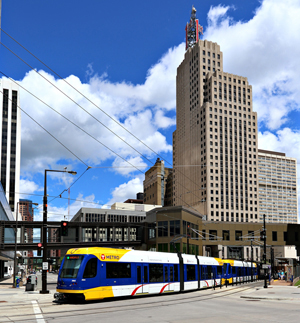
The unlikely train that connects a Twin Cities community
Chuck Salter is a senior writer at Fast Company, who produces and performs live, staged versions of in-depth stories. St. Paul, Minn., is one of 26 Knight communities.
The Green Line. Photo by Flickr user Jerry Huddleston.
“Trains are about journeys, and that’s what we’re embarking on today.”
So begins “The Green Line: Eleven Miles of Hopes, Dreams and Fears,” the story of how the new light rail line between Minneapolis and St. Paul, Minn., overcame nearly 30 years of uncertainty and turmoil before opening last summer. Transit projects of this magnitude—this one had a nearly $1 billion price tag—are inherently daunting, financially, politically and physically. In St. Paul, the line faced a psychological hurdle as well: the legacy of a transit project that tore apart the city’s largest African-American community 50 years earlier.
How this once-divisive train project became a reality is a complicated and inspiring story about the persistence, unusual collaborations and creative problem-solving necessary for transportation-led economic and community development.
RELATED LINKS
“The Green Line: The Scars of Rondo” from Fred T. Miller on Youtube
“The Green Line: New Collaborations” from Fred T. Miller on Youtube
“The Green Line: Saving Small Businesses” from Fred T. Miller on Youtube
“The Green Line: Which Side of the Tracks Do You Live On?” from Fred T. Miller on Youtube
“The Green Line: A Turning Point” from Fred T. Miller on Youtube
“The Green Line: Art to the Rescue” from Fred T. Miller on Youtube
“The Green Line: A Redemtpive Ride” from Fred T. Miller on Youtube
“In St. Paul, Minn., 16 projects share $530,000 in first Knight Green Line Challenge” by Polly Talen on Knight Blog, 10/14/14
After several months of reporting, I assembled some of the project’s key players at the Rail-Volution annual conference this past fall. I narrated the story as I would in a magazine, only instead of quoting my subjects, I let them tell their own stories, live and onstage, in an event funded by Knight Foundation.
The cast included:
- Nancy Homans, the senior policy director in the St. Paul’s mayor office, who had to win the trust of a skeptical community;
- Nick Khaliq, the former head of the St. Paul chapter of the NAACP, whose family had been displaced by I-94 construction in the 1960s;
- Jonathan Sage-Martinson, the then-director of the Central Corridor Funders Collaborative, who nurtured a series of improbable partnerships;
- Chris Ferguson, a small business owner trying to survive the upheaval of rail-line construction and prepare his and other businesses for possible new opportunities;
- Kathy Mouacheupao, an arts administrator determined to unite communities along the rail line before and after construction;
- Nekima Levy-Pounds, the co-founder of a nonprofit helping young African-American men run a new business along the light rail.
“The Green Line: Eleven Miles of Hopes, Dreams and Fears” is the story of their relationship to the controversial train. Whether they supported it or opposed it, they shaped the process as well as the final product. In the end, the project serves as a powerful case study for other communities.
The video that appears above is part one. For the complete narrative, click here.
Recent Content
-
Communitiesarticle ·
-
Communitiesarticle ·
-
Communitiesarticle ·


